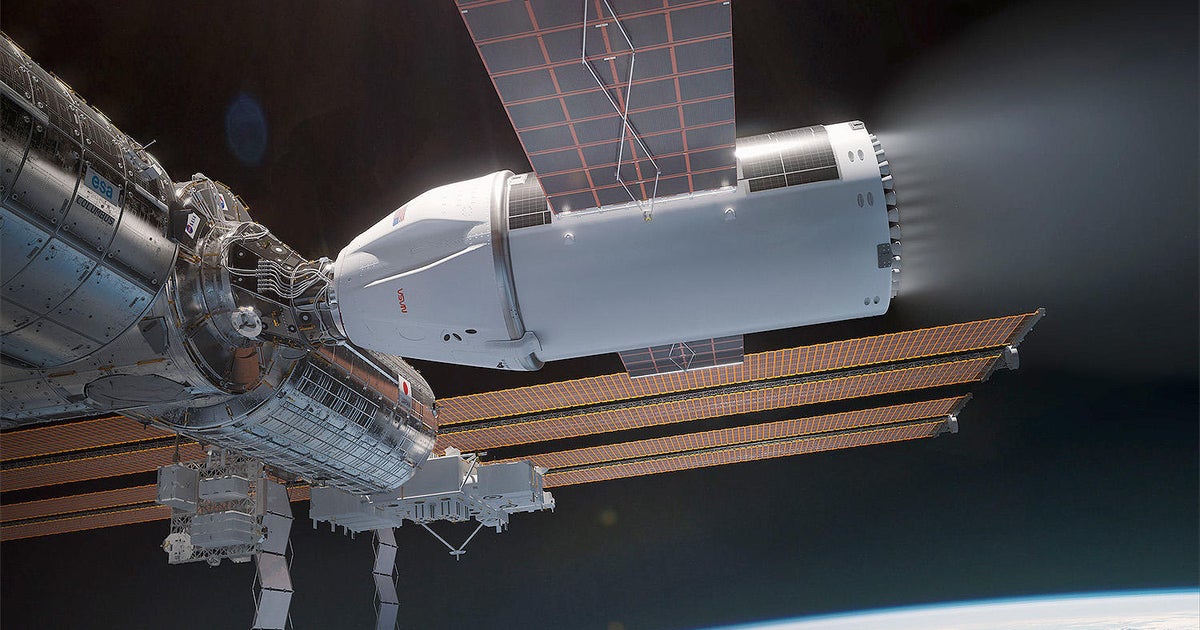CBS News
NASA plans for space station’s demise with new SpaceX “Deorbit Vehicle”

SpaceX is building a souped-up version of its cargo Dragon spacecraft to drive the International Space Station out of orbit for a controlled re-entry and breakup over an uninhabited stretch of ocean when the lab is finally retired in the 2030 timeframe, NASA and company officials said Wednesday.
The ISS Deorbit Vehicle, or DV, will be a custom-built, one-of-a-kind spacecraft needed to make sure the space station re-enters the atmosphere at the precise place and in the proper orientation to insure any wreckage that survives the 3,000-degree heat of re-entry will crash harmlessly into the sea.
SpaceX
In late June, NASA awarded SpaceX a contract valued at up to $843 million to build the deorbit vehicle, which will be owned and operated by the space agency. The heavy-lift rocket needed to launch it has not yet been selected, but NASA Administrator Bill Nelson has asked Congress for a total of about $1.5 billion to carry out the entire de-orbit operation.
And it is no trivial matter. The long axis of the space station, made up of multiple pressurized modules where visiting crews live and work, measures 218 feet long. The lab’s solar array power and cooling truss, mounted at right angles to the long axis, stretches 310 feet from end to end, longer than a U.S. football field.
The entire lab complex has a combined mass of 925,000 pounds and it’s moving through space at some 17,100 mph, or 84 football fields per second.
To carefully lower its altitude for a controlled re-entry, the DV will carry some 35,000 pounds of propellant powering 46 Draco rocket engines, 30 of which will be mounted in an extended trunk section to carry out the bulk of the deorbit maneuvers.
“When we do make the decision to deorbit station, we’ll launch the U.S. DV about one-and-a-half years before the final re-entry burn,” said Dana Weigel, the ISS program manager at the Johnson Space Center.
“We’ll dock it to the forward port, we will do a series of checkouts and then once we’re convinced that everything looks healthy and we’re ready, we’ll allow ISS to begin drifting down.”
The final space station crew will remain on board until periodic thruster firings and ever increasing “drag” in the extreme upper atmosphere combine to lower the lab to an altitude of about 205 miles. That milestone will be reached about six months before the final re-entry procedure.
As the by-then-uncrewed ISS reaches an altitude of about 140 miles, the DV “will perform a series of burns to set us up for that final deorbit,” Weigel said. “And then four days later, it will do the final re-entry burn.”
The space station’s large but relatively flimsy solar arrays will break off and burn up first, along with antennas, radiator panels and other appendages.
Maxar
More massive components — modules and the lab’s huge power truss — also will break apart in the hellish high-speed descent, but chunks as large as a small car are expected to survive all the way to ocean splashdown along a narrow 1,200-mile-long “footprint.”
Remote areas of the South Pacific Ocean offer unpopulated splashdown zones, although a final target has not yet been specified.
To achieve a precisely targeted entry, “the deorbit vehicle will need six times the usable propellant and three to four times the power generation and storage of today’s Dragon spacecraft,” said Sarah Walker, a senior manager at SpaceX.
“It needs enough fuel on board not just to complete the primary mission but also to operate in orbit in partnership with the space station for about 18 months. Then at the right time, it will perform a complex series of actions over several days to deorbit the International Space Station.”
A deorbit spacecraft of some sort is needed because even at the space station’s current altitude of 260 miles, trace amounts of the atmosphere still exist. As the station flies through that tenuous material at nearly 5 miles per second, collisions with those particles act to slow the craft every so slightly in a phenomenon known as atmospheric drag.
Over the life of the program, periodic thruster firings have been carried out by engines in Russian modules or attached Progress cargo ships to boost the lab’s altitude as needed to offset the effects of drag. More recently, Northrop Grumman’s Cygnus cargo ships have added modest reboost capability.
Without those carefully planned firings, the station eventually would crash back into the lower atmosphere on its own.
The station flies over every point on Earth between 51.6 degrees north and south latitude, covering the entire planet between London and the tip of South America. In an uncontrolled re-entry, station debris that survived entry heating could hit the surface anywhere in that area.
While the odds of impacts in a populated area are relatively small, nothing as massive as the space station has ever re-entered and fallen to Earth, and NASA is taking no chances.
NASA and its station partners — the European, Russian, Canadian and Japanese space agencies — planned from the beginning to deliberately drive the lab into the atmosphere at the end of its life to ensure breakup over an uninhabited stretch of ocean.
The original plan was to use thrusters in multiple Russian Progress cargo ships to lower the lab’s altitude and set up a targeted fall to Earth.
“Early on in the station planning, we had considered doing the deorbit through the use of three Progress vehicles,” Weigel said. “But the Roscosmos segment was not designed to control three Progress vehicles at one time. So that presented a bit of a challenge.
“And also, the capability wasn’t quite what we really needed for the size of station. So we jointly agreed together to go have U.S. industry take a look at what we could do on our side for the deorbit.”
Last year, NASA sought industry proposals and two companies responded: SpaceX and Northrop Grumman. The agency announced last week that SpaceX had won the contract.
CBS News
Here Comes the Sun: Jack Antonoff and more

Watch CBS News
Be the first to know
Get browser notifications for breaking news, live events, and exclusive reporting.
CBS News
Capturing Moriah Wilson’s Killer – CBS News

Watch CBS News
Be the first to know
Get browser notifications for breaking news, live events, and exclusive reporting.
CBS News
How to watch the Minnesota Vikings vs. Chicago Bears NFL game today: Livestream options, more

Getty Images
The Minnesota Vikings will take on the Chicago Bears today. The Vikings are currently 8-2, an impressive run so far this season, and will be looking to add a fourth win to their current streak after last Sunday’s 23-13 win against the Tennessee Titans. The Bears, on the other hand, are entering this game on the heels of a four-game losing streak after a tough 20-19 loss against the Green Bay Packers last Sunday.
Here’s how and when you can watch the Vikings vs. Bears game today, whether or not you have cable.
How and when to watch the Minnesota Vikings vs. Chicago Bears
The Vikings vs. Bears game will be played on Sunday, November 24, 2024 at 1:00 p.m. ET (11:00 a.m. PT). The game will air on Fox and stream on Fubo and the platforms featured below.
How and when to watch the Minnesota Vikings vs. Chicago Bears game without cable
You can watch this week’s NFL game on Fox via several streaming services. All you need is an internet connection and one of the top options outlined below.
Fubo offers you an easy, user-friendly way to watch NFL games on CBS, Fox, NBC, ABC, ESPN, and NFL Network, plus NCAA football channels. The Pro tier includes 200+ channels and unlimited DVR, while the Elite with Sports Plus tier adds NFL RedZone and 4K resolution. New subscribers get a seven-day free trial and all plans allow streaming on up to 10 screens simultaneously.
You can watch today’s game with a subscription to Sling’s Orange + Blue tier, which includes ESPN, ABC, NBC, and Fox. The plan offers 46 channels with local NFL games, nationally broadcast games and 50 hours of DVR storage. For complete NFL coverage, add Paramount+ to get CBS games, or upgrade with the Sports Extra add-on for additional sports channels like Golf Channel, NBA TV and NFL RedZone.
Watching NFL games, including Fox broadcasts, is simple with Hulu + Live TV, which includes 90 channels, unlimited DVR storage, and access to NFL preseason games, live regular season games and studio shows. The service includes ESPN+ and Disney+ in the subscription.
Want to watch today’s game live on your smartphone? If so, NFL+ streaming service is the solution you’re looking for. It lets you watch NFL Network and out-of-market games on mobile devices, with an upgrade option to NFL+ Premium that includes NFL RedZone for watching up to eight games simultaneously. Note that NFL+ only works on phones and tablets, not TVs.










